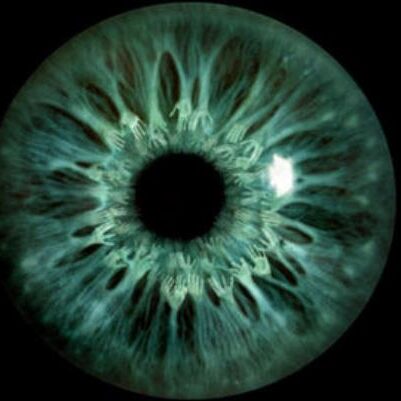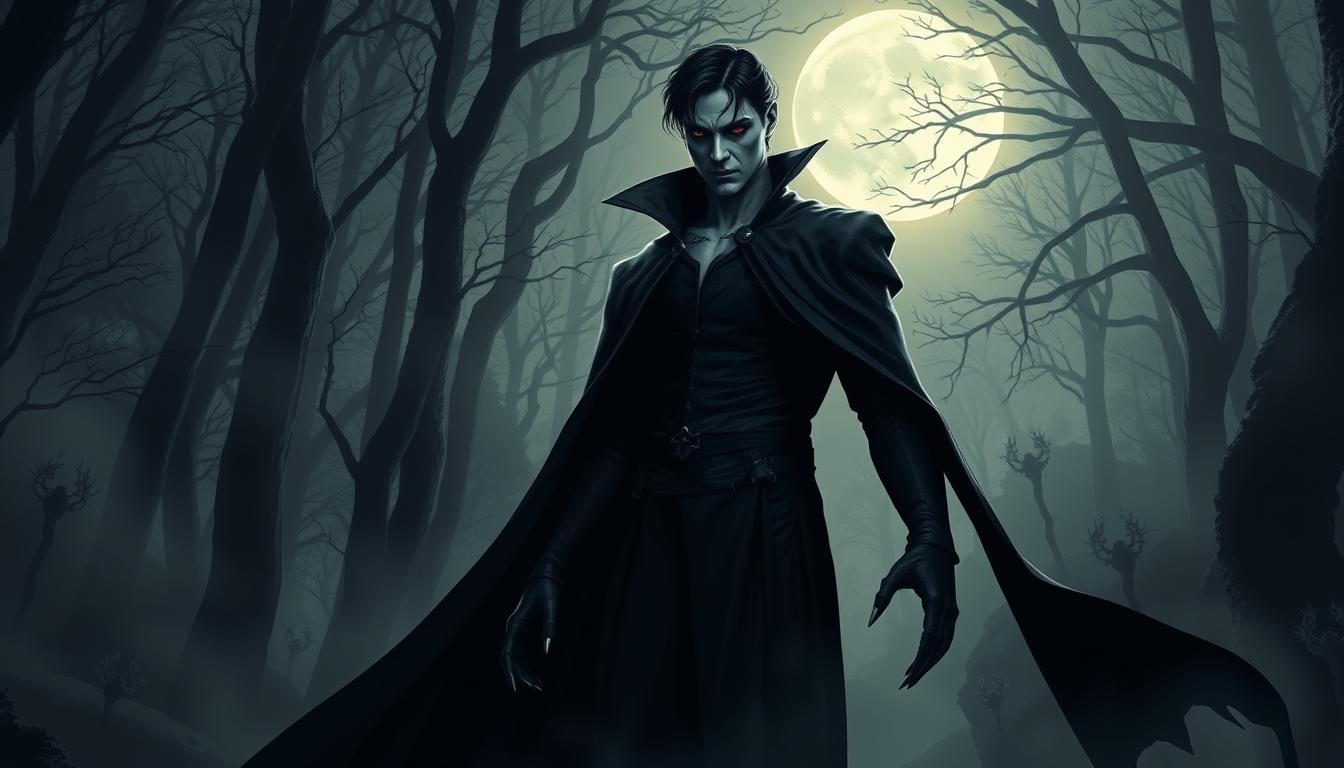The night was thick with an eerie silence, broken only by the distant howl of a wolf. As you walked the cobblestone streets, the flickering gaslight cast long, ominous shadows. You couldn’t help but feel a chill run down your spine. It was as if the very air was thick with the whispers of ancient, supernatural beings – the legendary vampires.
Vampires have captured our imaginations for centuries. Their allure spans across diverse cultures and eras. These mythical creatures, often linked to the macabre and supernatural, have grown from ancient Mesopotamian and Slavic folklore. They have become iconic in modern popular culture.
The idea of vampires, beings that feed on the blood of the living, comes from varied traditions. It has changed to reflect the fears and desires of different societies. Exploring vampires gives us a peek into the human psyche. It shows how these immortal creatures shape our imagination.
From medieval Europe’s haunting tales to modern literature and film, vampires continue to fascinate us. This leaves us wondering: do these undead beings truly exist?
Key Takeaways:
- Vampires have captivated human imagination for centuries, with roots in diverse folklore and traditions.
- The concept of blood-drinking, immortal beings has evolved to reflect the fears and desires of different societies.
- Exploring the origins and characteristics of vampires offers insights into the human psyche and the enduring appeal of these mythical creatures.
- Legends and depictions of vampires span from ancient Mesopotamia to modern popular culture.
- The question of whether vampires truly exist continues to intrigue and captivate audiences.
Introduction
The vampire fascination has been a big part of human stories for a long time. It crosses over different cultures and has lasted through the ages. These beings that drink blood are seen as symbols of our deepest fears and desires. They inspire stories, movies, and art.
The stories of vampires started long ago in ancient times. Back then, people told stories about spirits and demons that drank blood. In Eastern Europe, the idea of vampires really took off. The word “vampire” comes from the Slavic word “upir” or “nosferatu,” meaning a reanimated corpse that causes plagues and bad luck.
As time went on, stories about vampires spread all over Europe. They mixed with different cultures and traditions. This made the vampires we know today, with their special powers and weaknesses.
The Enduring Appeal of Vampire Mythology
Vampires have had a big effect on culture, in books, movies, and popular culture. They show us what it means to be human, from living forever to having desires. This makes them symbols that change with society.
Vampires are like mirrors for us, showing our deepest fears and secret desires. They have changed over time to fit with what people believe and worry about. This shows how powerful these creatures are in helping us face our fears and fantasies.
“The vampire is a mythical being that has captured the imagination of people around the world for centuries, reflecting the deepest fears and desires of humanity.”
Historical Origins of Vampire Folklore
The story of vampires goes way back to ancient times. In those days, people talked about blood-drinking entities and spirits. In Mesopotamian mythology, there was Lilitu, a demon linked to infant deaths. In Egypt, Sekhmet was seen as a bloodthirsty goddess. Greek folklore had its own vampires like Lamia and Empusa, who were said to lure children.
These stories from long ago helped create the vampire myths we know today. They spread across the world, changing over time.
Ancient Civilizations and Blood-Drinking Entities
In the Slavic regions of Eastern Europe, especially the Balkans, vampire myths really took off. The term “vampire” comes from the Slavic words “upir” or “nosferatu.” These referred to undead corpses blamed for sickness and death.
These stories from the Balkans greatly influenced vampire legends. They spread all over Europe and the world, giving us the vampires we know today.
“The concept of the vampire as an undead creature inflicting harm originated in Eastern Europe, specifically in Bulgaria, a thousand years ago.”
Slavic and Eastern European Influences
In the Middle Ages, vampire stories grew as the plague spread. People linked bleeding mouths after death to vampirism. The legend of vampires began to spread with German-speaking people taking over Hungary in 1686.
The word “vampire” first appeared in English in 1732. It came from Slavic peasants to big cities like Vienna and Paris. From there, it reached London and the Americas.
The book “Dracula” by Bram Stoker, published in 1897, made vampires famous. It introduced Count Dracula, a blood-sucking vampire figure. Vlad Drăculea, also known as Vlad the Impaler, who ruled Romania from 1448 to 1477, inspired Dracula.
Cultural Variations in Vampire Legends
Vampires have fascinated people all over the world for a long time. But, the way these creatures are seen and told has changed a lot. In China, there’s the “jiangshi,” a hopping vampire. In Romania, there’s the “strigoi.” These stories show how different cultures see vampires and what they fear.
Long ago, stories of blood-drinking demons were common in places like Mesopotamia, Greece, and Rome. In the early 1700s, in places like Transylvania, these stories grew and led to fear and violence. People thought some were vampires and acted out in a big way.
Even though vampires are seen differently around the world, some things stay the same. They are often linked to blood, the supernatural, and the fear of what we don’t know. These common themes show how vampire stories have lasted through time and cultures.
| Culture | Vampire Entities | Key Characteristics |
|---|---|---|
| Mesopotamia | Blood-drinking demons | Depicted on pottery sherds |
| Hebrew Tradition | Alukah (Leech) | Synonymous with vampirism |
| Indian Folklore | Vetalas, Pishacha | Ghoul-like beings, evil spirits with vampiric attributes |
| Ancient Greek Mythology | Empusa, Lamia, Striges | Considered precursors to modern vampires |
| Chinese Folklore | Jiangshi | Hopping vampire associated with death and the afterlife |
| Romanian Tradition | Strigoi | Undead souls of the wicked |
The cultural variations in vampire legends and the global vampire myths show how different cultures have shaped vampire stories. This mix of tales creates a rich world of vampire myths.
Defining Characteristics of Vampires
Anatomy and Physical Traits
Vampires are known for their unique look, making them seem otherworldly. They usually have pale skin, sharp fangs, and better senses like vision and hearing. Not showing up in mirrors is a common idea in stories about vampires. It shows they’re not fully alive or dead.
Supernatural Abilities and Vulnerabilities
Vampires have special powers that make them stand out. They can change into animals and control people’s minds. They also don’t age and live forever by drinking human blood.
But, they’re not invincible. They can’t handle sunlight well and are weakened by it. They’re also harmed by holy symbols, crosses, and holy water. Some plants, like garlic, can repel them too.
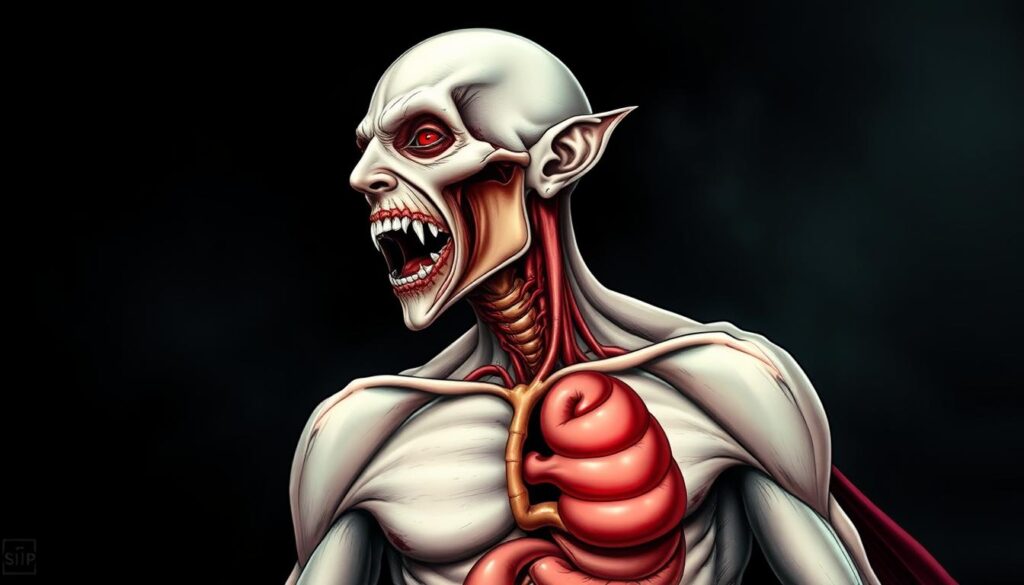
“The vampire is a being of the night – a creature of darkness and mystery. Its very existence blurs the line between the living and the dead, challenging our understanding of the world around us.”
Vampires have always fascinated people with their looks, powers, and weaknesses. This has made them a big part of our culture for centuries.
Do Vampires Exist?
Vampires have captured our imagination for centuries, but do they really exist? The idea of immortal beings that drink blood is popular in stories, movies, and culture. But, there’s little scientific proof they are real.
Yet, vampire stories are common in many cultures, making up over 98% of all folklore. This shows that the idea of vampires touches on deep human feelings and fears. Even if vampires might not be real, their stories are powerful.
Some people have acted strangely, like those in a 2015 survey who said they were real vampires. In New Orleans, known for its mysticism, vampire stories and sightings are common.
Sanguine vampires, who drink human blood, are rare. But psychic vampires, who take energy from others, are more common. Some say they can drain people’s energy, and some in the vampire community drink blood.
The question of whether vampires exist is still up in the air. Some doubt the stories, while others believe they might be real. As science grows, so does our interest in the supernatural. Finding proof of vampires is still a mystery.
“There is an actual ‘vampire’ subculture that exists among young people and likely other age groups that engage in disturbing activities.”
Vampires in Literature and Popular Culture
Vampires have always fascinated people, moving from books to movies, TV, and pop culture. They have left a lasting impact on our imagination. From the famous Count Dracula to the complex Lestat, they have shaped our views of the undead.
Iconic Literary Vampires
“Dracula” by Bram Stoker is a key work in vampire literature. It made Count Dracula a symbol of vampires, influencing many other stories. Another important vampire is Carmilla from Joseph Sheridan Le Fanu’s “Carmilla,” who brought lesbian themes to the genre.
Anne Rice’s “The Vampire Chronicles” series, with its star Lestat, has also changed vampire literature. It mixed romance, horror, and deep thoughts. This series has made vampires more complex and interesting.
Depictions in Film and Television
Vampires have moved from books to movies and TV, showing many different sides. Bela Lugosi’s Count Dracula in the 1931 film started a trend of suave vampires. Since then, vampires have been seen in many films and TV shows, from old horror movies to modern, romantic takes.
These different views show how society and culture change over time. They keep vampires popular and interesting in media.
| Iconic Vampire Portrayals | Notable Actors |
|---|---|
| Count Dracula | Bela Lugosi, Christopher Lee, Gary Oldman |
| Lestat | Tom Cruise, Stuart Townsend |
| Carmilla | Ingrid Pitt, Courteney Cox |
| Spike | James Marsters |
| Blade | Wesley Snipes |
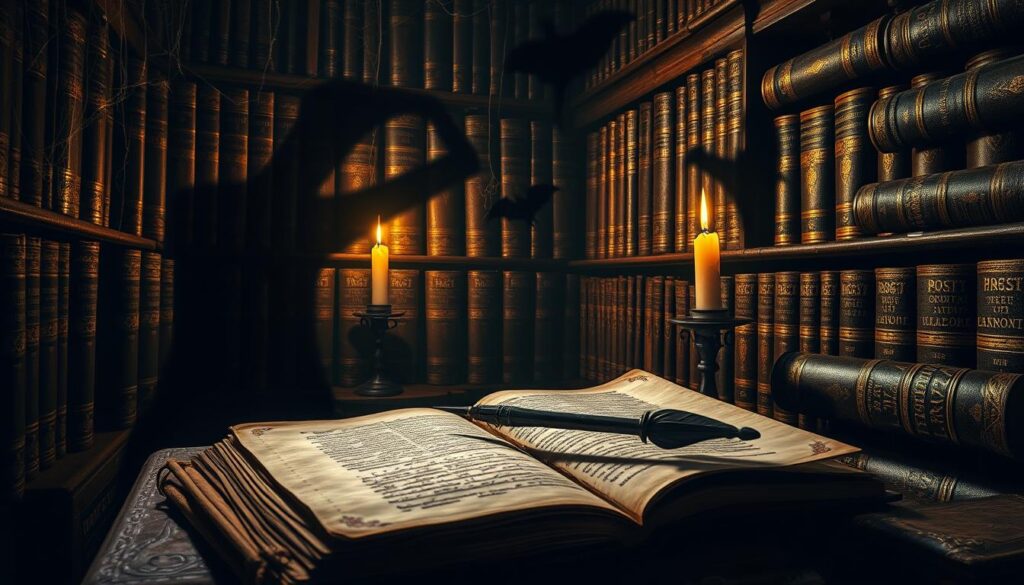
Vampires in stories and popular culture are loved for their mix of mystery, danger, and deep human themes. They keep changing, showing us the evolving culture and our own nature.
The Enduring Appeal of Vampires
Vampires have been fascinating humans for centuries. Their lasting charm comes from representing many symbolic meanings and cultural worries. They are immortal beings that challenge the natural order. This makes them symbols for our fears and desires.
They let us look into themes like death, sexuality, power, and the mix of good and evil.
The story of vampires goes back to ancient times. These blood-drinking beings were part of many cultures’ folklore. By the 19th century, they moved from stories to literature.
The first mention in English was in a poem by Lord Byron in 1813. Then, “The Vampyre” by John William Polidori in 1819 started the romantic vampire genre. Bram Stoker’s “Dracula” in 1897 made Count Dracula the top vampire image.
Vampire stories change over time and across cultures. They reflect the worries and interests of each era. This makes them interesting and lasting.
From charming aristocrats in the 19th century to modern, complex anti-heroes, vampires keep drawing people in. Their supernatural charm lets us see our deepest human feelings.
Vampires are everywhere in media, from books and movies to TV shows, plays, and musicals. There are thousands of vampire movies, with “Dracula” being a top horror character. This shows how vampires have always been popular.
“Vampires are seductive because they allow us to explore our own fears and desires in a safe, fictional context. They represent the allure of the dark, the promise of immortality, and the power to transcend the limitations of our mortal existence.”
Vampires keep being relevant and changing with time. They can be charming aristocrats, complex anti-heroes, or modern monsters. They keep fascinating us, showing us the deep parts of our minds.
Symbolism and Metaphors in Vampire Mythology
Vampires go beyond just being fictional characters. They are powerful symbols and metaphors that show our deepest anxieties and desires. They represent our fear of death, our hidden urges, and our interest in the forbidden.
Throughout history, vampires have been linked to many societal fears. These include worries about disease, being different, and religious beliefs. At the same time, they also symbolize the dream of living forever, being deeply sensual, and having power beyond what humans have.
By looking into the symbols and metaphors of vampires, we learn a lot about ourselves. We see how these mythical beings continue to fascinate and connect with us.
Vampires as Reflections of Societal Fears and Desires
Vampires are often seen as symbols of fear of disease and contagion. Their need for blood and the idea of spreading a “curse” show our fear of getting sick and losing control over our lives.
Also, vampires are tied to fears of being different and religious intolerance. Their ability to look like us but be very different can make us uneasy. It shows our fear of the unknown and our dislike for those who are different.
On the other hand, vampires also symbolize the dream of living forever, being very sensual, and having great power. Their never-ending life and magical abilities excite our imagination. They show our wish to go beyond what we can do as humans. The way vampires are often shown as very attractive taps into our deepest wishes and dreams.
Understanding vampires as symbols and metaphors helps us see into the human mind, our fears, and our desires. These mythical beings keep captivating us, showing the lasting and common nature of human experiences.
Exploring the Aversion to Sunlight
Vampires are known for avoiding sunlight. This fear of daylight is a key part of their lore. It adds depth to their stories and symbols.
Being active at night makes vampires seem mysterious. They live in the shadows, far from the daylight. This contrast highlights their unique place between life and death.
Vampires can’t handle sunlight, showing they’re not of this world. This makes them seem more dangerous and mysterious. It also adds tension to stories, as they try to survive in daylight.
The symbolism of sunlight in vampire mythology is deep. Sunlight stands for life and order. Vampires, on the other hand, are linked to darkness and death. This shows how vampires live outside the natural world.
Some real health issues might have inspired vampire lore. Porphyria makes people look pale and have big teeth, like vampires. Garlic, with its antibiotic allicin, was thought to keep vampires away in old stories.
| Condition | Connection to Vampire Mythology |
|---|---|
| Porphyria | Causes sensitivity to sunlight, pale skin, and enlarged teeth, resembling vampire traits |
| Rabies | Epidemic in Eastern Europe before the 18th century, linked to vampire hysteria and spread by rabid wolves and potentially humans |
| Pellagra | Causes sensitivity to sunlight, foul breath, and other symptoms resembling vampire folklore, linked to the “Great Vampire Epidemic” |
The why vampires avoid sunlight and the symbolism of sunlight in vampire mythology are key to their lasting charm. By looking into significance of vampire vulnerability to daylight, we see how vampires capture our imagination.
The Mirror Enigma
One of the most enduring enigmas in vampire mythology is the belief that these immortal creatures do not cast a reflection in mirrors. This belief is deeply rooted in folklore and traditional beliefs. It symbolizes the vampire’s connection to the supernatural and their existence beyond the mortal world.
In many cultures, mirrors were seen as portals to the soul or gateways to the spiritual realm. The absence of a vampire’s reflection in a mirror was seen as a sign of their soullessness. It showed they didn’t have a physical presence in the living world. This idea has become a key part of vampire lore, adding to their mystery and the line between the living and the undead.
Folklore and Traditional Beliefs
Legends of vampires have been found in nearly every culture around the world for many centuries. These immortal beings are said to survive by consuming blood or life essence. The significance of no vampire reflection is deeply rooted in these traditional beliefs about vampires and mirrors.
- Vampires cannot enter a private home unless invited in by the owner or someone with the authority to do so.
- Exposing a vampire to direct sunlight destroys it utterly.
- Vampires have a multitude of weaknesses and limitations that cannot be overcome.
- Vampires do not cast shadows nor possess a reflection.
The enduring appeal of vampire mirror reflection and the traditional beliefs about vampires and mirrors lies in their ability to reflect the human condition. They capture our fears, desires, and societal anxieties in a captivating and enduring mythology.
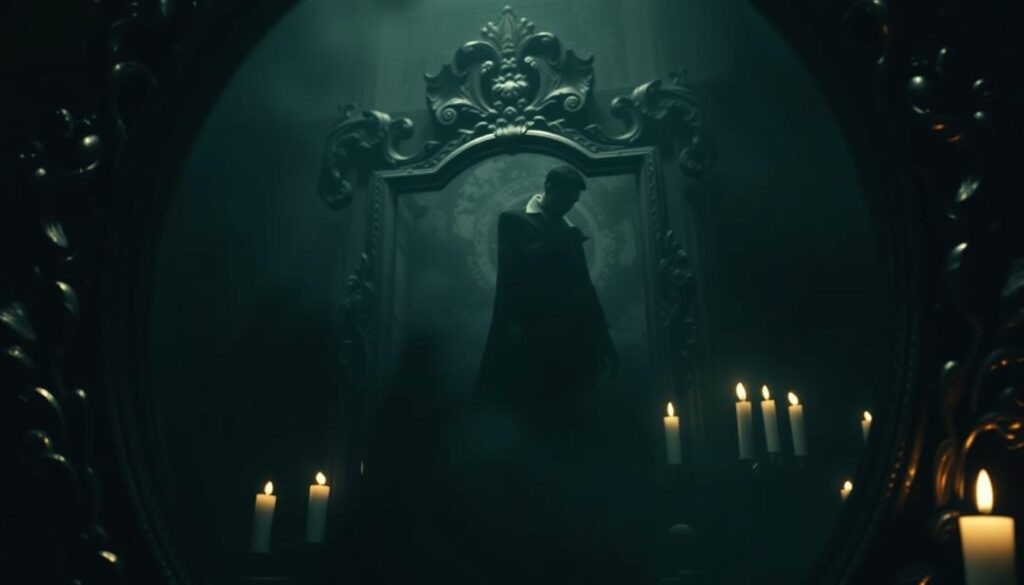
“The absence of a vampire’s reflection in a mirror was interpreted as a sign of their soullessness or their lack of a physical presence in the living world.”
Psychological and Sociological Perspectives
Vampires are more than just myths; they let us explore our deepest desires and fears. They represent our wishes for immortality, power, and forbidden desires. Their ability to live forever shows our fascination with the supernatural and the unknown.
At the same time, vampires scare us with thoughts of mortality, disease, and losing control. Sociologically, they mirror the worries of different cultures and times. They act as symbols for fears like xenophobia, religious intolerance, and losing traditional values.
Desires and Fears Embodied by Vampires
Looking into the psychological significance of vampires and their sociological meaning helps us understand why they fascinate us. The desires and fears they represent show how complex we are as humans.
“Vampires, as mythical creatures, serve as powerful conduits for the exploration of human desires and fears.”
From ancient times to today, vampires have always captured our minds. They let us see the psychological and sociological underpinnings of being human.
Evolution of Vampire Depictions
Vampires have changed a lot over time. They went from being seen as monsters to being more like us in stories and movies. Bram Stoker’s Count Dracula was a key figure in this change, being both noble and scary. Then, Anne Rice’s “Interview with the Vampire” in the 20th century made vampires more emotional and deep.
Now, vampires in movies and TV shows mix horror, romance, and fantasy. These new depictions of vampires show how society and culture change. They also show our ongoing interest in myths and the supernatural.
From Legends to Modern Portrayals
Vampires have been part of stories for thousands of years, from ancient Ireland to Greece. These stories were often used to scare people and teach them about cultural norms. They were seen as outsiders, threatening the community.
Over time, vampires in stories changed from being just scary to being more complex. The Hammer Horror series, for example, made vampires sexy and appealing. This mix of horror and romance drew in fans.
| Vampire Depiction | Notable Examples | Key Characteristics |
|---|---|---|
| Monstrous and Sinister | Bram Stoker’s Dracula | Aristocratic, blood-thirsty, and sinister |
| Charismatic and Erotic | Hammer Horror’s Dracula | Fancy, seductive, and appealing to audiences |
| Emotionally Complex | Anne Rice’s “Interview with the Vampire” | Exploring the psychological and emotional nuances of vampires |
| Diverse Representations | Blacula, Dark Shadows | Incorporating vampires into diverse genres and audiences |
The way we see vampires has changed a lot over time. It shows how society and culture change, and our ongoing interest in myths and the supernatural. From the scary Dracula to today’s more complex vampires, these characters keep fascinating us.
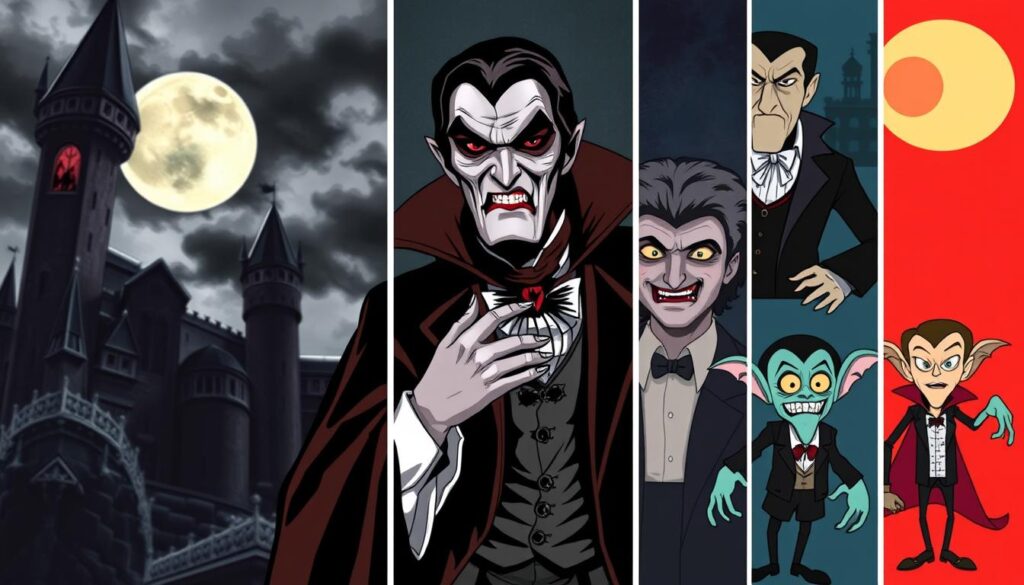
“Vampires symbolize a failure to adhere to cultural norms and expectations within a society, representing an ‘otherness.'”
Conclusion
Vampires have been a part of human stories for centuries. They come from ancient times and folklore from all over the world. These creatures have changed over time, showing our changing fears, desires, and worries.
From the scary Dracula to the romantic vampires in movies and books, they keep catching our attention. They let us explore our deepest feelings and thoughts.
The story of vampires shows why we find them so interesting. Their changing images in stories show our fascination with the unknown and our darker sides. Vampires symbolize our fears and desires for power and forever life.
Looking ahead, vampires will keep changing and staying in stories and popular culture. The story of vampires shows they will always capture our interest. They help us understand ourselves and the world around us.
FAQ
Do vampires exist?
There’s no solid proof that vampires, the blood-drinking beings from stories and movies, really exist. Yet, some people have acted strangely, making us wonder if there’s truth to vampire legends.
What are the origins of vampire mythology?
Long ago, stories of vampire-like beings were found in many cultures, like Mesopotamia, Egypt, and Greece. But it was in Eastern Europe, especially the Balkans, that the modern idea of vampires took hold. The word “vampire” comes from Slavic words like “upir” or “nosferatu.”
How have vampire legends evolved across different cultures?
Vampires have been a part of many cultures, but they’re not the same everywhere. In China, the “jiangshi” is a hopping vampire linked to death. In Romania, the “strigoi” are evil spirits that never die. These stories show how different cultures see vampires in their own ways.
What are the defining characteristics of vampires?
Vampires are often seen as pale, with sharp fangs and great senses. They can change shape, hypnotize people, and live forever by drinking blood. But they’re not invincible; they can be harmed by sunlight and certain objects.
How have vampires been portrayed in literature and popular culture?
Vampires have been in books for a long time, with famous characters like Count Dracula and Lestat. They’ve moved from books to movies and TV, becoming big cultural icons. Over time, they’ve changed to reflect what people think and feel about them.
Why are vampires so fascinating to people?
Vampires capture our interest because they can mean many things to us. They live forever, which makes us think about death and life. They also let us explore deep feelings like fear and desire. Through the ages, vampires have changed to match the worries and dreams of each era.
